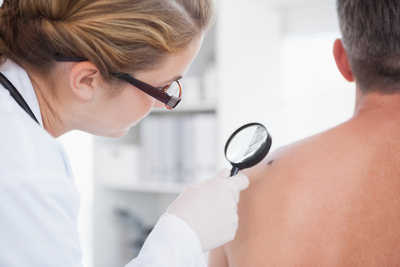Sun Spots vs. Skin Cancer: Spotting the Difference for Early Detection
 Sun spots and skin cancer can sometimes look similar, leading to confusion and anxiety. However, distinguishing between these two conditions is vital for early detection and effective treatment. With this comprehensive guide, Schweiger Dermatology Group will help you understand the difference between sun spots and skin cancer, recognize the warning signs, and take proactive steps to protect your skin.
Sun spots and skin cancer can sometimes look similar, leading to confusion and anxiety. However, distinguishing between these two conditions is vital for early detection and effective treatment. With this comprehensive guide, Schweiger Dermatology Group will help you understand the difference between sun spots and skin cancer, recognize the warning signs, and take proactive steps to protect your skin.
What Are Sun Spots?
Sun spots, also known as solar lentigines or age spots, are flat, brown or black spots that develop on areas of the skin that have been exposed to the sun over time. These spots are a direct result of sun damage and tend to appear more frequently as you age. Although they are generally harmless, the presence of sunspots on the skin indicates significant exposure to ultraviolet (UV) rays, which can elevate your risk of skin cancer.
Understanding Skin Cancer
Skin cancer is one of the most common types of cancer worldwide, and it occurs when skin cells grow uncontrollably due to DNA damage, often caused by UV rays. The three main types of skin cancer are basal cell carcinoma, squamous cell carcinoma and melanoma. Among these, melanoma is the most dangerous and can develop from existing moles.
Sun Spots or Skin Cancer? 7 Key Differences
Although sun spots and skin cancer can have similarities in appearance, there are ways to distinguish. These seven factors can help differentiate:
- Appearance: Sun spots are typically flat, round or oval in shape and range in color from light brown to dark brown or black. They tend to appear in clusters and are uniform in color. Skin cancer, particularly melanoma, may have an irregular shape and show multiple colors, including red, white or blue, often within the same lesion.
- Borders: Sun spots usually have well-defined, smooth edges. In contrast, skin cancer, especially melanoma, often have uneven, jagged or blurred borders, making them harder to define.
- Size: Sun spots tend to be small, with most being less than 1 cm in diameter. Skin cancer, particularly melanoma, often starts small but can grow rapidly, exceeding 6 mm (about the size of a pencil eraser) or more.
- Texture: Sun spots remain smooth and do not typically change in texture. Skin cancer, however, may become raised, crusty, or develop an uneven surface as they grow.
- Growth: Sun spots do not change much over time, remaining consistent in size and color. Skin cancer, on the other hand, can grow, change color, or become painful, itchy, or bleed, which are all signs of a potentially serious problem.
- Location: Sun spots are commonly found on areas of the body that have been exposed to the sun for long periods, such as the face, shoulders and hands. While skin cancer does appear in sun-exposed areas, it can also develop anywhere on the body, including places with minimal sun exposure like the scalp or soles of the feet.
- Risk Factors: While sun spots themselves are harmless, their presence indicates significant sun exposure, increasing the risk of developing skin cancer in the future. Skin cancer, particularly melanoma, can also be influenced by genetic factors, a history of severe sunburns, or a weakened immune system.
Can Sun Spots Turn Into Cancer?
While sun spots are benign and non-cancerous, they are a visible reminder of sun damage and indicate a higher risk of developing skin cancer. The same UV exposure that causes sun spots can also lead to mutations in skin cells, potentially resulting in skin cancer over time. Therefore, while sun spots do not turn into cancer directly, they signify the need for vigilant skin monitoring and protective measures.
Prevention Strategies for Sun Spots and Skin Cancer
Protecting your skin from the sun is the best way to prevent both sun spots and skin cancer. Here are some effective ways to do that:
- Use Sunscreen Daily: Apply a broad-spectrum sunscreen with at least SPF 30 daily, even on cloudy days. Reapply every two hours when outdoors, and after swimming or sweating.
- Seek Shade: Avoid direct sunlight during peak hours, typically between 10 AM and 4 PM, when UV rays are strongest.
- Wear Protective Clothing: Long sleeves, wide-brimmed hats and sunglasses can provide additional protection against UV rays.
- Avoid Tanning Beds: Tanning beds emit UV radiation that can lead to significant sun damage and increase your risk of skin cancer.
- Conduct Regular Self-Exams: Use a full-length mirror to inspect hard-to-see areas and document any changes in your moles or sun spots.
- Visit a Dermatology Provider: Schedule regular skin exams with a dermatology provider, especially if you have a history of sun exposure or a family history of skin cancer.
The Importance of Skin Cancer Early Detection
Early detection of skin cancer significantly improves the chances of successful skin cancer treatment. Skin cancer, particularly melanoma, can progress rapidly if left untreated, making early detection the only way to prevent the spread to other parts of the body. Dermatology providers utilize various diagnostic tools and techniques to assess suspicious spots and lesions, ensuring that any potential cancerous sun spots are identified and addressed promptly.
Skin Cancer Screening & Skin Checks at Schweiger Dermatology Group
Remember, staying proactive is the best way to safeguard your skin’s health. If you ever have concerns about a spot on your skin, our team of highly skilled and experienced dermatology specialists conduct mole evaluations, skin cancer screenings and more. To schedule an appointment don’t hesitate to seek Schweiger Dermatology Group, call us at (844) DERM-DOC or book online.
